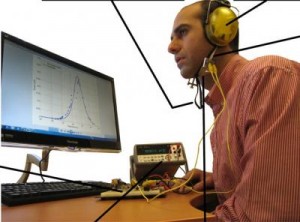Who knew that jaw movements have proved to be amongst the most promising activities for energy-harvesting? Apparently, scientists know and are coming up with ways to enjoy the harvest. From a Sept. 16, 2014 news item on Nanowerk,
A chin strap that can harvest energy from jaw movements has been created by a group of researchers in Canada.
It is hoped that the device can generate electricity from eating, chewing and talking, and power a number of small-scale implantable or wearable electronic devices, such as hearing aids, cochlear implants, electronic hearing protectors and communication devices.
An Institute of Physics (IOP) Sept. 16, 2014 news release (also on EurekAlert), which generated the news item, explains just why jaw movements are so exciting and how the researchers went about ‘harvesting’,
Jaw movements have proved to be one of the most promising candidates for generating electricity from human body movements, with researchers estimating that an average of around 7 mW of power could be generated from chewing during meals alone.
To harvest this energy, the study’s researchers, from Sonomax-ÉTS Industrial Research Chair in In-ear Technologies (CRITIAS) at École de technologie supérieure (ÉTS) in Montreal, Canada, created a chinstrap made from piezoelectric fibre composites (PFC).
PFC is a type of piezoelectric smart material that consists of integrated electrodes and an adhesive polymer matrix. The material is able to produce an electric charge when it stretches and is subjected to mechanical stress.
In their study, the researchers created an energy-harvesting chinstrap made from a single layer of PFC and attached it to a pair of earmuffs using a pair of elastic side straps. To ensure maximum performance, the chinstrap was fitted snugly to the user, so when the user’s jaw moved it caused the strap to stretch.
To test the performance of the device, the subject was asked to chew gum for 60 seconds while wearing the device; at the same time the researchers recorded a number of different parameters.
The maximum amount of power that could be harvested from the jaw movements was around 18 µW, but taking into account the optimum set-up for the head-mounted device, the power output was around 10 µW.
Co-author of the study Aidin Delnavaz said: “Given that the average power available from chewing is around 7 mW, we still have a long way to go before we perfect the performance of the device.
“The power level we achieved is hardly sufficient for powering electrical devices at the moment; however, we can multiply the power output by adding more PFC layers to the chinstrap. For example, 20 PFC layers, with a total thickness of 6 mm, would be able to power a 200 µW intelligent hearing protector.”
One additional motivation for pursuing this area of research is the desire to curb the current dependency on batteries, which are not only expensive to replace but also extremely damaging to the environment if they are not disposed of properly.
“The only expensive part of the energy-harvesting device is the single PFC layer, which costs around $20. Considering the price and short lifetime of batteries, we estimate that a self-powered hearing protector based on the proposed chinstrap energy-harvesting device will start to pay back the investment after three years of use,” continued Delnavaz.
“Additionally, the device could substantially decrease the environmental impact of batteries and bring more comfort to users.
“We will now look at ways to increase the number of piezoelectric elements in the chinstrap to supply the power that small electronic devices demand, and also develop an appropriate power management circuit so that a tiny, rechargeable battery can be integrated into the device.”
Here’s a look at the ‘smart chinstrap’,

Caption: This is the experimental set up of an energy harvesting chin strap.
Credit: Smart Materials and Structures/IOP Publishing
I don’t see anyone rushing to get a chinstrap soon. Hopefully they’ll find a way to address some of the design issues. In the meantime, here’s a link to and a citation for the paper,
Flexible piezoelectric energy harvesting from jaw movements by Aidin Delnavaz and Jérémie Voix. 2014 Smart Mater. Struct. 23 105020 doi:10.1088/0964-1726/23/10/105020
This is an open access paper.